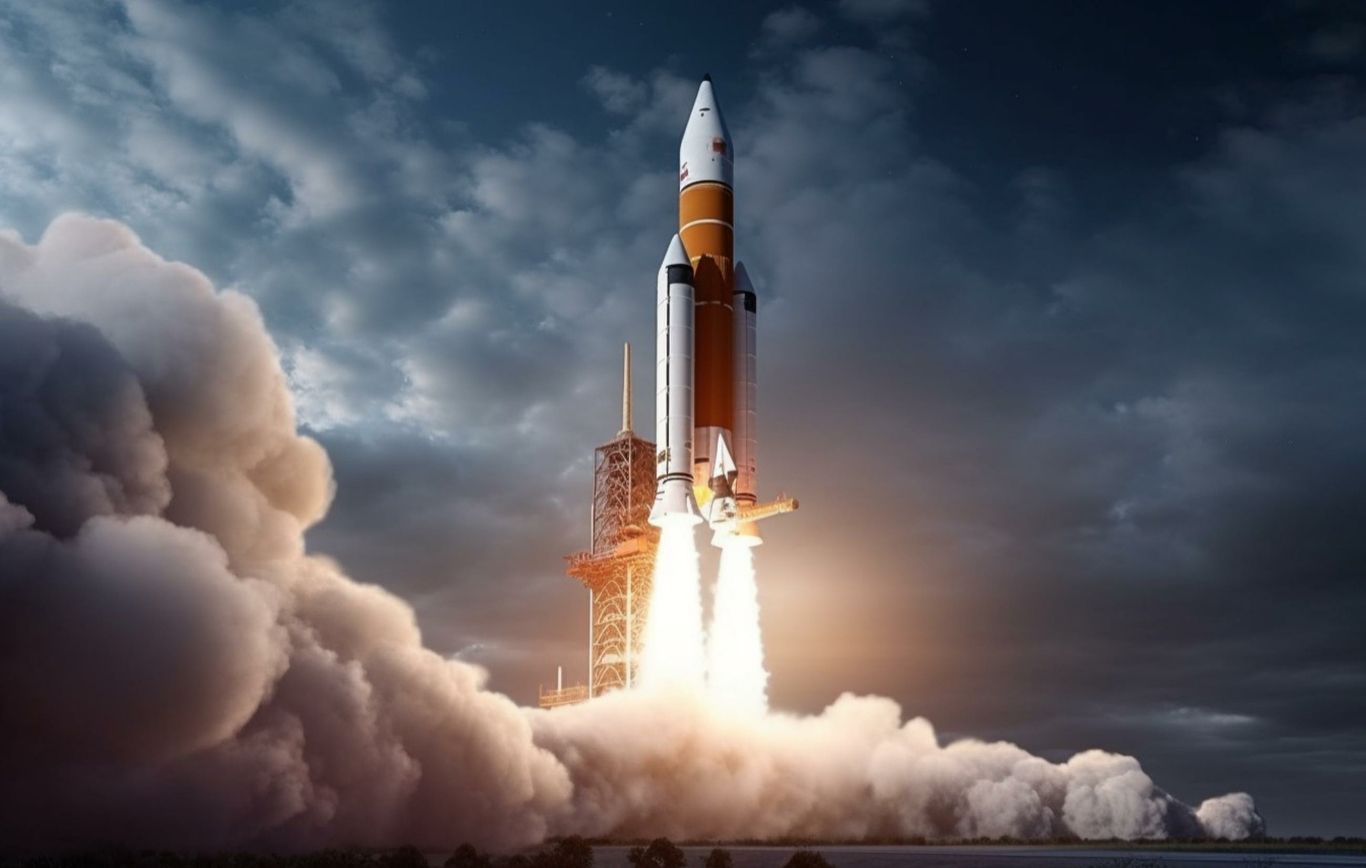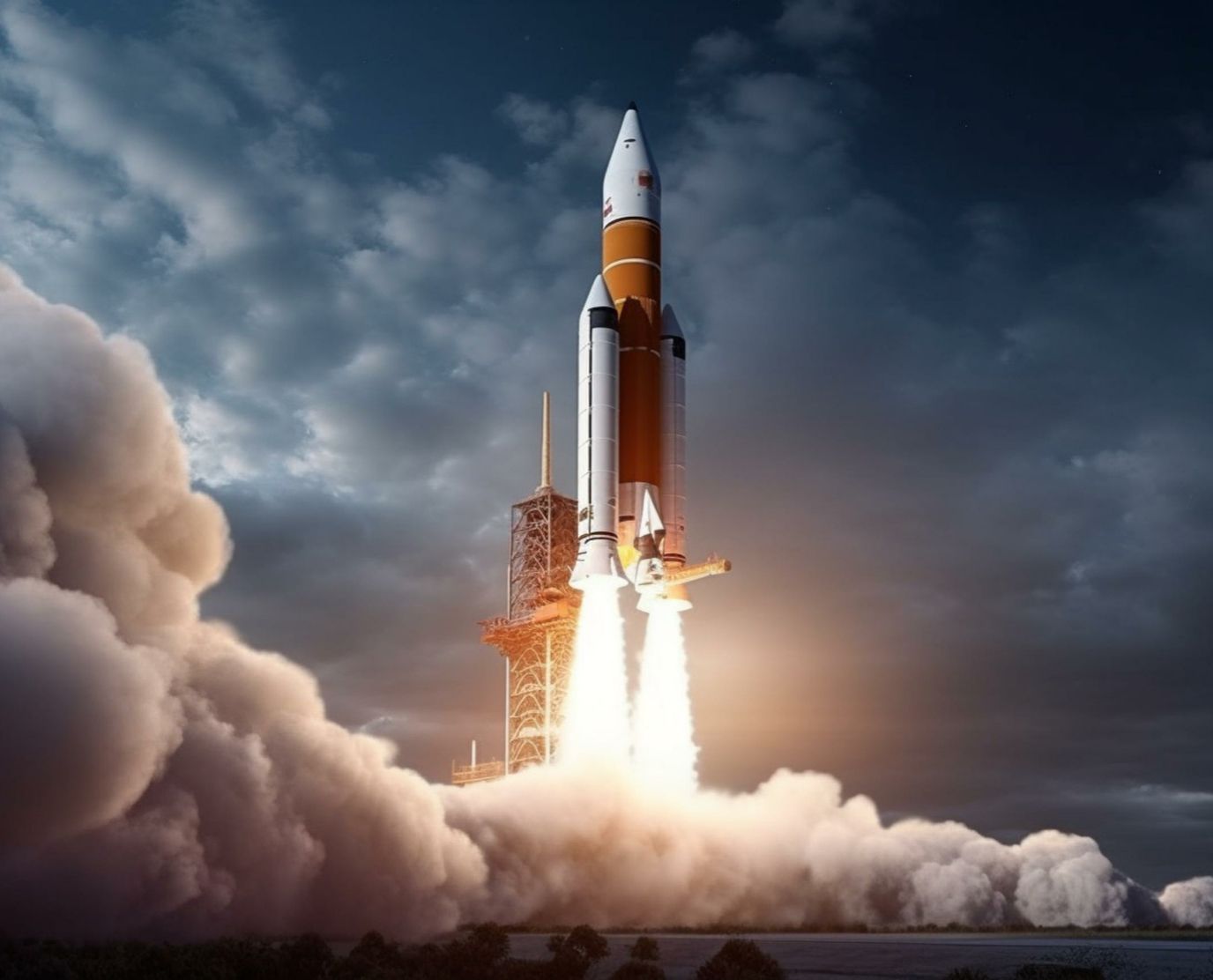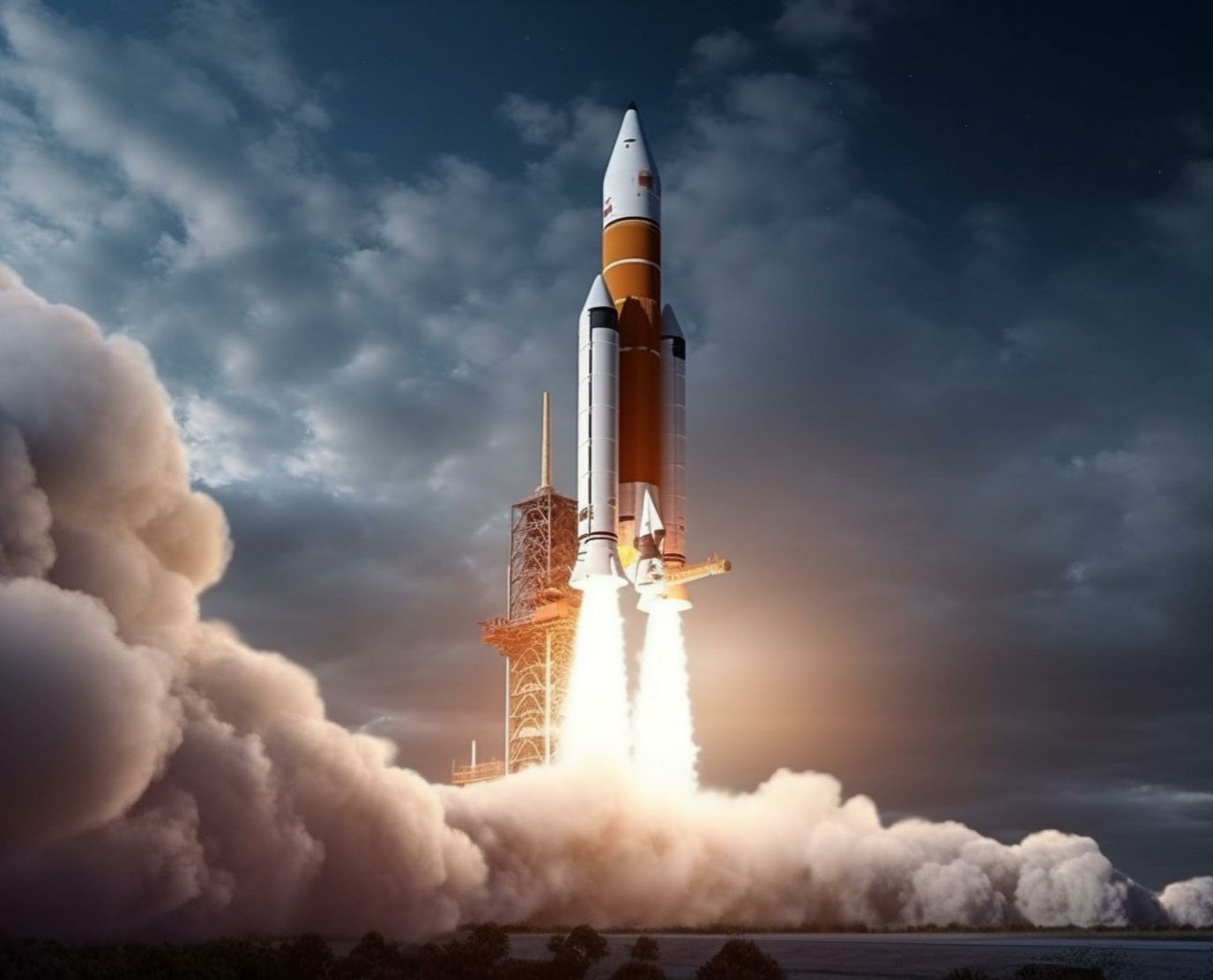01 September 2023

Does Artemis place too much strain on US space? (Image: Adobe)
US fiscal challenges, the rise of India, and the value of blockchain in space
After achieving their milestone soft landing at the lunar south pole last week, India have continued to make their mark in the space sector. Chandrayaan-3 landed on the Moon, making India the fourth nation to successfully do so, and have since released their Pragyan rover to explore the lunar surface and analyse the make-up of the soil and regolith. Most importantly perhaps, the mission aims to search for water ice, a key resource for supporting humankind’s ongoing occupation of the Moon.
Their rover is already making key discoveries and the Indian Space Research Organisation (ISRO) said on Monday that “The Laser-Induced Breakdown Spectroscopy (LIBS) instrument onboard Chandrayaan-3 Rover has made the first-ever in-situ measurements on the elemental composition of the lunar surface near the south pole,”. They have confirmed the presence of aluminium, calcium, iron, chromium, titanium, manganese, silicon and oxygen.
The mission has not only been a technical feat, but also a lesson in cost effective approaches to space exploration. The mission had a relatively low budget of $75mn, and has proved that India can do much more with less money. This kind of efficiency is what may lead India to continue its rise as a modern space power and open-up access to space.
India will not stay quiet either and just two weeks after the arrival of Chandrayaan-3, ISRO will launch their Aditya-L1 probe to study solar winds. The spacecraft will carry payloads to observe the the outer layers of the sun.
With this success, and the rise of their private sector, we can expect a lot more to come from India in future.
Japan lunar mission delayed, but robotics company presses on
Japan will be close behind India, with their SLIM (Smart Lander for Investigating Moon) and X-Ray Imaging and Spectroscopy Mission, aiming to become the fifth nation to land safely on the Moon. The mission was meant to launch on the 26th August, but been delayed due to high winds, now aiming for the 15th September.
The mission will demonstrate precision landing technology and carry two rovers; Lunar Excursion Vehicle 1 (LEV-1), a hopping rover that can directly communicate with ground stations on Earth, and Lunar Excursion Vehicle 2 (LEV-2), a tiny rover capable of changing its shape to traverse the lunar surface.
Japanese offworld robotics company, GITAI, have had motivating news regarding their lunar exploration plans, with the raising of an additional $15 million. The money will be used to continue development of their space robotics, including their “Inchworm” robotic arm, which could be used for a number of applications, including constructing infrastructure on the Moon.
Japan and India aren’t necessarily new space powers, but their increasing presence and activity goes to show that space no longer belongs to the few.
US fiscal challenges, blockchain applications for space
Undoubtedly, it is the US that still lead the way in space. However, NASA and the US government will be increasingly aware of the rise of nations such as India and China, especially as they continue to face fiscal challenges and the fallout from the Biden administration’s debt ceiling measures, which keeps non-defence related budgets flat until 2025.
NASA has delayed the call for proposals for its New Frontiers programme until no earlier than 2026, due to uncertainly surrounding budgets. The programme is “designed to accomplish focused planetary science investigations” (NASA), answering questions about the solar system.
Furthermore, budget demands are impacting NASA’s Deep Space Network (DSN), a worldwide network of American ground facilities, which support US space missions, such as the Artemis lunar programme. Moreover, it has been noted how much strain that Artemis puts on the system, with Suzanne Dodd, director of the interplanetary network directorate at NASA’s Jet Propulsion Laboratory, saying that “When Artemis comes online, everybody else moves out of the way, and it’s an impact to all the science missions.”
With NASA and the US seemingly in a “lunar space race” with China, the US government may be looking increasingly towards the private sector for support. Commercialisation of space has been seen to reduce costs and increase efficiency in the sector, and has also been used effectively in Ukraine with, for example, the use of satellite imaging and communications. It may be the case the US need to further integrate the private sector into their national goals in space.
The US will also look to the private sector for rapid and responsive access to space, and this week have triggered the “Victus Nox” responsive launch demonstration with launch company, Firefly Aerospace. Firefly, alongside Millennium Space, will enter a standby phase, where at any point they will be given notice to integrate a satellite into their Alpha rocket. They will then have a 24 hour window to prep the launch and await a suitable launch window.
The Defense Innovation Unit is also seeking bids for a second demonstration, named “Victus Haze”.
The US may be facing financial challenges right now, with NASA budgets being affected, but they may find that their best chance of keeping ahead of their competition is to lean more on their powerful and innovate private sector.
Crytpo and blockchain technology for space
In November, Intuitive Machine’s lander will be launched to the Moon, hoping to be the first commercial mission to safely arrive in the surface. One of the payloads will be DOGE-1, which is entirely paid for with the cryptocurrency, Dogecoin. The main purpose of the mission is to broadcast advertisements and logos on a screen built in the satellite.
After the first announcement of the mission in 2021, Elon Musk (famous supporter of Dogecoin) said it will be the “1st crypto in space”. DOGE-1 will also launch atop a SpaceX Falcon-9. It’s still somewhat unknown what Musk’s plans are with the cryptocurrency, especially in regards to space exploration, but this it has been suggested the he intends to incorporate the currency into X.com (formerly twitter), as it is believed that he wants to turn the social media outlet into a new form payment platform, such as PayPal.
Other cryptocurrencies are being established for their use in the space ecosystem. Marscoin (MARS) aims to use blockchain to let users trade crypto while also funding space exploration missions, and SaceXCoin (SPXC) looks to be the “leading currency for interplanetary missions, funding travel, habitation, agriculture and entertainment complexes across the galaxy” (coinmarketcap.com).
Blockchain not only about finance for space
As well as transporting DOGE-1 to the Moon, Intuitive Machines are also exploring the use of blockchain in a new partnership with Crisium Ltd. They aim to use the decentralised nature of blockchain to lower barriers of entry to the market and encourage cooperation in space.
Steve Altemus, Chief Executive Officer of Intuitive Machines said that "Web3 can provide Intuitive Machines with a new set of tools to create an inclusive exploration community that provides access to individuals, small businesses, and communities that have traditionally been excluded from the space industry.”
We are in contentious times in space, with a lack of legislation and a potential race to secure orbital slots and lunar resources. Intuitive Machine’s mission to open-up space and encourage transparency could be a vision that would benefit the many in New Space.
An article from DT Next this week, celebrating the success of Chandrayaan-3, suggests how India might also use blockchain to become a true leader on space technology. The author, Raj Kapoor, says that private companies are exploring how data from space missions could be stored in tokens and monetised, and then use the capital to fund further missions. He also suggests that manufacturing and supply chains could be made more efficient using the chain, increasing customer transparency.
Cryptocurrency and blockchain may have gained a somewhat tarred reputation after a dramatic crash in 2022. However, for space, the chain could provide more possibilities for trade, finance, transparency and inclusion.

Transastra also to remove debris (Image: Adobe)
Transastra to capture debris, priority on orbital infrastructure
Last week we discussed the developments regarding space debris removal companies ClearSpace (Swiss) and Astroscale (Japan). The focus on debris mediation seems to be continuing, and this week it was announced that space infrastructure company, TransAstra, has received a NASA contract to develop a “capture bag” for debris removal.
TransAstra already developed a small bag in 2021, originally for asteroid mining purposes. However, the company then became aware that the same tech can be used for debris collection. Furthermore, the company, alongside startup ThinkOrbital, have suggested that instead of bringing debris back into Earth’s atmosphere, it could actually be processed in-orbit, dramatically increasing efficiency and reducing costs.
Cleaning-up and maintaining Earth-orbit is all part of the goal of developing a sophisticated orbital infrastructure. One company working towards this end is Impulse Space, established by former SpaceX founding employee, Tom Mueller. The company this week announced tat they have raised $45 million, which will go towards developing its orbital transfer vehicles (OTVs).
With 1000s more objects being sent into space, Mueller sees the value in being able to effectively move objects in to their desired orbits, and even anticipates transporting vehicle to the Moon or Mars. Also, they will soon support startup, Orbit Fab, for an in-space refuelling demonstration. The demand for OTVs seems set to grow, and Impulse will carry out their first mission, LEO Express-1, no earlier than November this year.
External Links
This Week
*News articles posted here are not property of ANASDA GmbH and belong to their respected owners. Postings here are external links only.
Our future in space

(Image: Adobe)
01 September 2023
US fiscal challenges, the rise of India, and the value of blockchain in space - Space News Roundup
After achieving their milestone soft landing at the lunar south pole last week, India have continued to make their mark in the space sector. Chandrayaan-3 landed on the Moon, making India the fourth nation to successfully do so, and have since released their Pragyan rover to explore the lunar surface and analyse the make-up of the soil and regolith. Most importantly perhaps, the mission aims to search for water ice, a key resource for supporting humankind’s ongoing occupation of the Moon.
Their rover is already making key discoveries and the Indian Space Research Organisation (ISRO) said on Monday that “The Laser-Induced Breakdown Spectroscopy (LIBS) instrument onboard Chandrayaan-3 Rover has made the first-ever in-situ measurements on the elemental composition of the lunar surface near the south pole,”. They have confirmed the presence of aluminium, calcium, iron, chromium, titanium, manganese, silicon and oxygen.
The mission has not only been a technical feat, but also a lesson in cost effective approaches to space exploration. The mission had a relatively low budget of $75mn, and has proved that India can do much more with less money. This kind of efficiency is what may lead India to continue its rise as a modern space power and open-up access to space.
India will not stay quiet either and just two weeks after the arrival of Chandrayaan-3, ISRO will launch their Aditya-L1 probe to study solar winds. The spacecraft will carry payloads to observe the the outer layers of the sun.
With this success, and the rise of their private sector, we can expect a lot more to come from India in future.
Japan lunar mission delayed, but robotics company presses on
Japan will be close behind India, with their SLIM (Smart Lander for Investigating Moon) and X-Ray Imaging and Spectroscopy Mission, aiming to become the fifth nation to land safely on the Moon. The mission was meant to launch on the 26th August, but been delayed due to high winds, now aiming for the 15th September.
The mission will demonstrate precision landing technology and carry two rovers; Lunar Excursion Vehicle 1 (LEV-1), a hopping rover that can directly communicate with ground stations on Earth, and Lunar Excursion Vehicle 2 (LEV-2), a tiny rover capable of changing its shape to traverse the lunar surface.
Japanese offworld robotics company, GITAI, have had motivating news regarding their lunar exploration plans, with the raising of an additional $15 million. The money will be used to continue development of their space robotics, including their “Inchworm” robotic arm, which could be used for a number of applications, including constructing infrastructure on the Moon.
Japan and India aren’t necessarily new space powers, but their increasing presence and activity goes to show that space no longer belongs to the few.
US fiscal challenges, blockchain applications for space
Undoubtedly, it is the US that still lead the way in space. However, NASA and the US government will be increasingly aware of the rise of nations such as India and China, especially as they continue to face fiscal challenges and the fallout from the Biden administration’s debt ceiling measures, which keeps non-defence related budgets flat until 2025.
NASA has delayed the call for proposals for its New Frontiers programme until no earlier than 2026, due to uncertainly surrounding budgets. The programme is “designed to accomplish focused planetary science investigations” (NASA), answering questions about the solar system.
Furthermore, budget demands are impacting NASA’s Deep Space Network (DSN), a worldwide network of American ground facilities, which support US space missions, such as the Artemis lunar programme. Moreover, it has been noted how much strain that Artemis puts on the system, with Suzanne Dodd, director of the interplanetary network directorate at NASA’s Jet Propulsion Laboratory, saying that “When Artemis comes online, everybody else moves out of the way, and it’s an impact to all the science missions.”
With NASA and the US seemingly in a “lunar space race” with China, the US government may be looking increasingly towards the private sector for support. Commercialisation of space has been seen to reduce costs and increase efficiency in the sector, and has also been used effectively in Ukraine with, for example, the use of satellite imaging and communications. It may be the case the US need to further integrate the private sector into their national goals in space.
The US will also look to the private sector for rapid and responsive access to space, and this week have triggered the “Victus Nox” responsive launch demonstration with launch company, Firefly Aerospace. Firefly, alongside Millennium Space, will enter a standby phase, where at any point they will be given notice to integrate a satellite into their Alpha rocket. They will then have a 24 hour window to prep the launch and await a suitable launch window.
The Defense Innovation Unit is also seeking bids for a second demonstration, named “Victus Haze”.
The US may be facing financial challenges right now, with NASA budgets being affected, but they may find that their best chance of keeping ahead of their competition is to lean more on their powerful and innovate private sector.
Crytpo and blockchain technology for space
In November, Intuitive Machine’s lander will be launched to the Moon, hoping to be the first commercial mission to safely arrive in the surface. One of the payloads will be DOGE-1, which is entirely paid for with the cryptocurrency, Dogecoin. The main purpose of the mission is to broadcast advertisements and logos on a screen built in the satellite.
After the first announcement of the mission in 2021, Elon Musk (famous supporter of Dogecoin) said it will be the “1st crypto in space”. DOGE-1 will also launch atop a SpaceX Falcon-9. It’s still somewhat unknown what Musk’s plans are with the cryptocurrency, especially in regards to space exploration, but this it has been suggested the he intends to incorporate the currency into X.com (formerly twitter), as it is believed that he wants to turn the social media outlet into a new form payment platform, such as PayPal.
Other cryptocurrencies are being established for their use in the space ecosystem. Marscoin (MARS) aims to use blockchain to let users trade crypto while also funding space exploration missions, and SaceXCoin (SPXC) looks to be the “leading currency for interplanetary missions, funding travel, habitation, agriculture and entertainment complexes across the galaxy” (coinmarketcap.com).
Blockchain not only about finance for space
As well as transporting DOGE-1 to the Moon, Intuitive Machines are also exploring the use of blockchain in a new partnership with Crisium Ltd. They aim to use the decentralised nature of blockchain to lower barriers of entry to the market and encourage cooperation in space.
Steve Altemus, Chief Executive Officer of Intuitive Machines said that "Web3 can provide Intuitive Machines with a new set of tools to create an inclusive exploration community that provides access to individuals, small businesses, and communities that have traditionally been excluded from the space industry.”
We are in contentious times in space, with a lack of legislation and a potential race to secure orbital slots and lunar resources. Intuitive Machine’s mission to open-up space and encourage transparency could be a vision that would benefit the many in New Space.
An article from DT Next this week, celebrating the success of Chandrayaan-3, suggests how India might also use blockchain to become a true leader on space technology. The author, Raj Kapoor, says that private companies are exploring how data from space missions could be stored in tokens and monetised, and then use the capital to fund further missions. He also suggests that manufacturing and supply chains could be made more efficient using the chain, increasing customer transparency.
Cryptocurrency and blockchain may have gained a somewhat tarred reputation after a dramatic crash in 2022. However, for space, the chain could provide more possibilities for trade, finance, transparency and inclusion.

Transastra also to remove debris (Image: Adobe)
Transastra to capture debris, priority on orbital infrastructure
Last week we discussed the developments regarding space debris removal companies ClearSpace (Swiss) and Astroscale (Japan). The focus on debris mediation seems to be continuing, and this week it was announced that space infrastructure company, TransAstra, has received a NASA contract to develop a “capture bag” for debris removal.
TransAstra already developed a small bag in 2021, originally for asteroid mining purposes. However, the company then became aware that the same tech can be used for debris collection. Furthermore, the company, alongside startup ThinkOrbital, have suggested that instead of bringing debris back into Earth’s atmosphere, it could actually be processed in-orbit, dramatically increasing efficiency and reducing costs.
Cleaning-up and maintaining Earth-orbit is all part of the goal of developing a sophisticated orbital infrastructure. One company working towards this end is Impulse Space, established by former SpaceX founding employee, Tom Mueller. The company this week announced tat they have raised $45 million, which will go towards developing its orbital transfer vehicles (OTVs).
With 1000s more objects being sent into space, Mueller sees the value in being able to effectively move objects in to their desired orbits, and even anticipates transporting vehicle to the Moon or Mars. Also, they will soon support startup, Orbit Fab, for an in-space refuelling demonstration. The demand for OTVs seems set to grow, and Impulse will carry out their first mission, LEO Express-1, no earlier than November this year.
Share this article
External Links
This Week
*News articles posted here are not property of ANASDA GmbH and belong to their respected owners. Postings here are external links only.
01 September 2023
US fiscal challenges, the rise of India, and the value of blockchain in space - Space News Roundup

Does Artemis place too much strain on US space? (Image: Adobe)
After achieving their milestone soft landing at the lunar south pole last week, India have continued to make their mark in the space sector. Chandrayaan-3 landed on the Moon, making India the fourth nation to successfully do so, and have since released their Pragyan rover to explore the lunar surface and analyse the make-up of the soil and regolith. Most importantly perhaps, the mission aims to search for water ice, a key resource for supporting humankind’s ongoing occupation of the Moon.
Their rover is already making key discoveries and the Indian Space Research Organisation (ISRO) said on Monday that “The Laser-Induced Breakdown Spectroscopy (LIBS) instrument onboard Chandrayaan-3 Rover has made the first-ever in-situ measurements on the elemental composition of the lunar surface near the south pole,”. They have confirmed the presence of aluminium, calcium, iron, chromium, titanium, manganese, silicon and oxygen.
The mission has not only been a technical feat, but also a lesson in cost effective approaches to space exploration. The mission had a relatively low budget of $75mn, and has proved that India can do much more with less money. This kind of efficiency is what may lead India to continue its rise as a modern space power and open-up access to space.
India will not stay quiet either and just two weeks after the arrival of Chandrayaan-3, ISRO will launch their Aditya-L1 probe to study solar winds. The spacecraft will carry payloads to observe the the outer layers of the sun.
With this success, and the rise of their private sector, we can expect a lot more to come from India in future.
Japan lunar mission delayed, but robotics company presses on
Japan will be close behind India, with their SLIM (Smart Lander for Investigating Moon) and X-Ray Imaging and Spectroscopy Mission, aiming to become the fifth nation to land safely on the Moon. The mission was meant to launch on the 26th August, but been delayed due to high winds, now aiming for the 15th September.
The mission will demonstrate precision landing technology and carry two rovers; Lunar Excursion Vehicle 1 (LEV-1), a hopping rover that can directly communicate with ground stations on Earth, and Lunar Excursion Vehicle 2 (LEV-2), a tiny rover capable of changing its shape to traverse the lunar surface.
Japanese offworld robotics company, GITAI, have had motivating news regarding their lunar exploration plans, with the raising of an additional $15 million. The money will be used to continue development of their space robotics, including their “Inchworm” robotic arm, which could be used for a number of applications, including constructing infrastructure on the Moon.
Japan and India aren’t necessarily new space powers, but their increasing presence and activity goes to show that space no longer belongs to the few.
US fiscal challenges, blockchain applications for space
Undoubtedly, it is the US that still lead the way in space. However, NASA and the US government will be increasingly aware of the rise of nations such as India and China, especially as they continue to face fiscal challenges and the fallout from the Biden administration’s debt ceiling measures, which keeps non-defence related budgets flat until 2025.
NASA has delayed the call for proposals for its New Frontiers programme until no earlier than 2026, due to uncertainly surrounding budgets. The programme is “designed to accomplish focused planetary science investigations” (NASA), answering questions about the solar system.
Furthermore, budget demands are impacting NASA’s Deep Space Network (DSN), a worldwide network of American ground facilities, which support US space missions, such as the Artemis lunar programme. Moreover, it has been noted how much strain that Artemis puts on the system, with Suzanne Dodd, director of the interplanetary network directorate at NASA’s Jet Propulsion Laboratory, saying that “When Artemis comes online, everybody else moves out of the way, and it’s an impact to all the science missions.”
With NASA and the US seemingly in a “lunar space race” with China, the US government may be looking increasingly towards the private sector for support. Commercialisation of space has been seen to reduce costs and increase efficiency in the sector, and has also been used effectively in Ukraine with, for example, the use of satellite imaging and communications. It may be the case the US need to further integrate the private sector into their national goals in space.
The US will also look to the private sector for rapid and responsive access to space, and this week have triggered the “Victus Nox” responsive launch demonstration with launch company, Firefly Aerospace. Firefly, alongside Millennium Space, will enter a standby phase, where at any point they will be given notice to integrate a satellite into their Alpha rocket. They will then have a 24 hour window to prep the launch and await a suitable launch window.
The Defense Innovation Unit is also seeking bids for a second demonstration, named “Victus Haze”.
The US may be facing financial challenges right now, with NASA budgets being affected, but they may find that their best chance of keeping ahead of their competition is to lean more on their powerful and innovate private sector.
Crytpo and blockchain technology for space
In November, Intuitive Machine’s lander will be launched to the Moon, hoping to be the first commercial mission to safely arrive in the surface. One of the payloads will be DOGE-1, which is entirely paid for with the cryptocurrency, Dogecoin. The main purpose of the mission is to broadcast advertisements and logos on a screen built in the satellite.
After the first announcement of the mission in 2021, Elon Musk (famous supporter of Dogecoin) said it will be the “1st crypto in space”. DOGE-1 will also launch atop a SpaceX Falcon-9. It’s still somewhat unknown what Musk’s plans are with the cryptocurrency, especially in regards to space exploration, but this it has been suggested the he intends to incorporate the currency into X.com (formerly twitter), as it is believed that he wants to turn the social media outlet into a new form payment platform, such as PayPal.
Other cryptocurrencies are being established for their use in the space ecosystem. Marscoin (MARS) aims to use blockchain to let users trade crypto while also funding space exploration missions, and SaceXCoin (SPXC) looks to be the “leading currency for interplanetary missions, funding travel, habitation, agriculture and entertainment complexes across the galaxy” (coinmarketcap.com).
Blockchain not only about finance for space
As well as transporting DOGE-1 to the Moon, Intuitive Machines are also exploring the use of blockchain in a new partnership with Crisium Ltd. They aim to use the decentralised nature of blockchain to lower barriers of entry to the market and encourage cooperation in space.
Steve Altemus, Chief Executive Officer of Intuitive Machines said that "Web3 can provide Intuitive Machines with a new set of tools to create an inclusive exploration community that provides access to individuals, small businesses, and communities that have traditionally been excluded from the space industry.”
We are in contentious times in space, with a lack of legislation and a potential race to secure orbital slots and lunar resources. Intuitive Machine’s mission to open-up space and encourage transparency could be a vision that would benefit the many in New Space.
An article from DT Next this week, celebrating the success of Chandrayaan-3, suggests how India might also use blockchain to become a true leader on space technology. The author, Raj Kapoor, says that private companies are exploring how data from space missions could be stored in tokens and monetised, and then use the capital to fund further missions. He also suggests that manufacturing and supply chains could be made more efficient using the chain, increasing customer transparency.
Cryptocurrency and blockchain may have gained a somewhat tarred reputation after a dramatic crash in 2022. However, for space, the chain could provide more possibilities for trade, finance, transparency and inclusion.

Transastra also to remove debris (Image: Adobe)
Transastra to capture debris, priority on orbital infrastructure
Last week we discussed the developments regarding space debris removal companies ClearSpace (Swiss) and Astroscale (Japan). The focus on debris mediation seems to be continuing, and this week it was announced that space infrastructure company, TransAstra, has received a NASA contract to develop a “capture bag” for debris removal.
TransAstra already developed a small bag in 2021, originally for asteroid mining purposes. However, the company then became aware that the same tech can be used for debris collection. Furthermore, the company, alongside startup ThinkOrbital, have suggested that instead of bringing debris back into Earth’s atmosphere, it could actually be processed in-orbit, dramatically increasing efficiency and reducing costs.
Cleaning-up and maintaining Earth-orbit is all part of the goal of developing a sophisticated orbital infrastructure. One company working towards this end is Impulse Space, established by former SpaceX founding employee, Tom Mueller. The company this week announced tat they have raised $45 million, which will go towards developing its orbital transfer vehicles (OTVs).
With 1000s more objects being sent into space, Mueller sees the value in being able to effectively move objects in to their desired orbits, and even anticipates transporting vehicle to the Moon or Mars. Also, they will soon support startup, Orbit Fab, for an in-space refuelling demonstration.
The demand for OTVs seems set to grow, and Impulse will carry out their first mission, LEO Express-1, no earlier than November this year.
Share this article
External Links
This Week
*News articles posted here are not property of ANASDA GmbH and belong to their respected owners. Postings here are external links only.
















